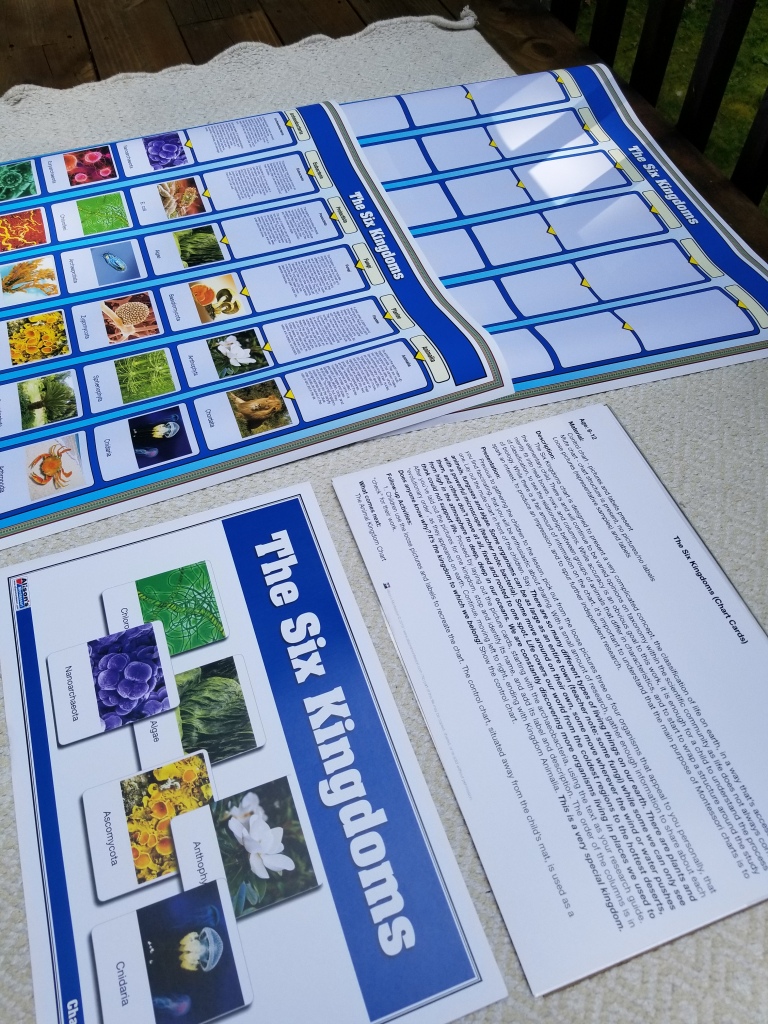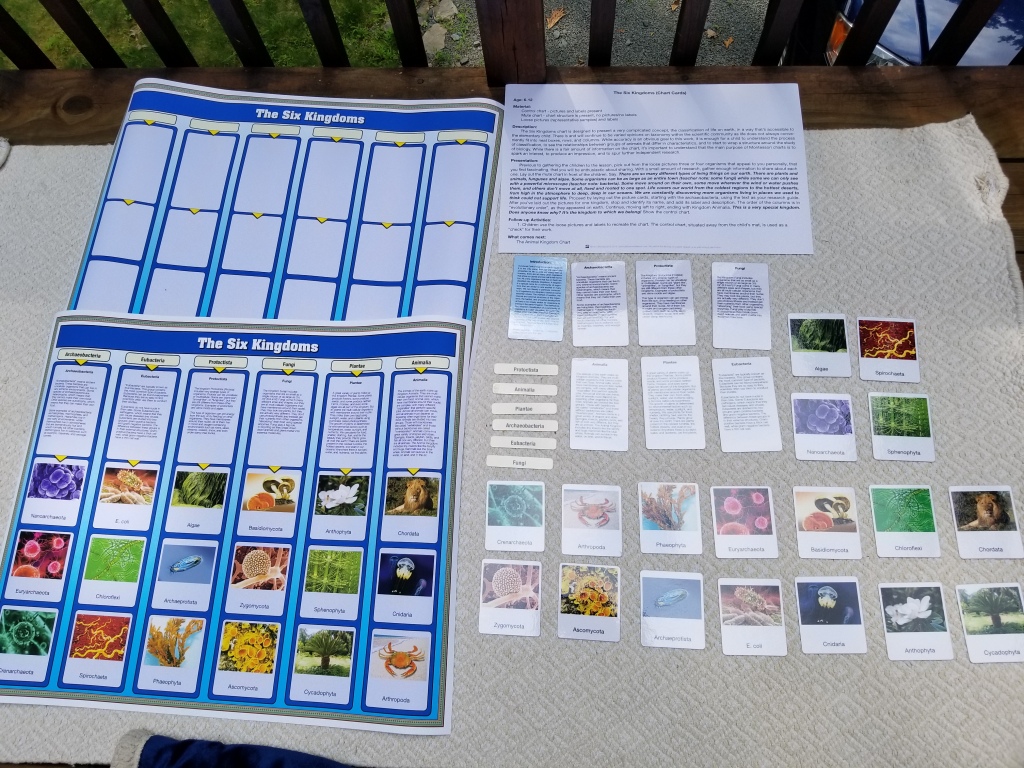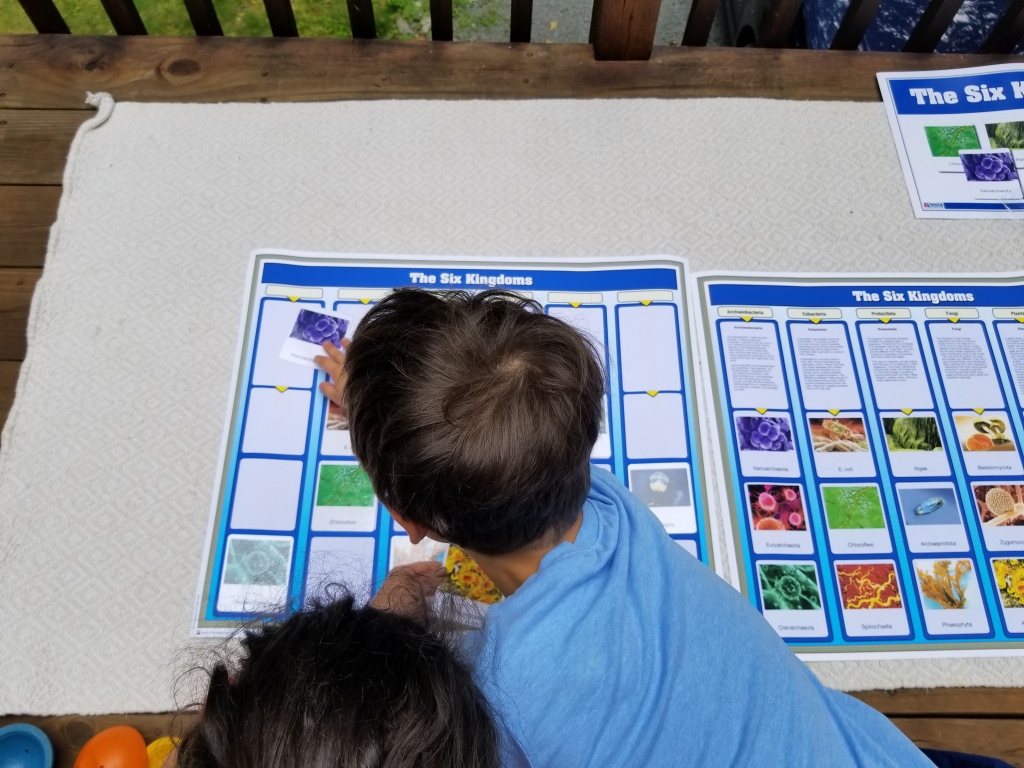Zoology 6-9+

The Six Kingdoms chart follows the Three Domains chart, and precedes the Animal Kingdom chart. We have been studying the Three Domains Charts from Alison’s Montessori, which is in concordance with the rest of the materials that we will be using in zoology.


In this post, I am presenting the Six Kingdoms chart, but you may also find the Five Kingdoms chart on the market. The only difference is that the Archebacteria have their own kingdom, away from Bacteria. Note that the scientific community is staying away from classification through “kingdoms” in favor of cladistics. Cladistics are regrouped based on common ancestry rather than common physical structure and functioning.
However, in a Montessori framework, we use charts as a light switch to research. This taxonomy sparks interest in children, who develop a deeper appreciation for living organisms.
The start:
This set consists in:
- A control chart (with pictures)
- A mute chart (to place pictures, labels, descriptions)
- 18 colorful pictures (3 pictures per kingdom)
- 6 description cards with definition for each kingdom
- 6 labels to name each kingdom
- Bonus: Instructions (all you need to know and say!)

We started by remembering all 7 characteristics of living organisms (move, respire, sense, grow, reproduce, excrete, and feed). We looked at the pictures and agreed that they all had in common being living organisms. We looked at the control chart and read all the description cards. The children were then in charge of place all the pictures on the mute chart, while I would place the description cards. I waited for them to be done; they were so excited.


The Six Kingdoms charts come with a clear and concise lesson that includes prerequisites and that addresses scientific views on the controversial topic of “Kingdoms.”

The description cards are well-written, again, in an age-appropriate sophisticated language. They contain the etymology of the words to help children learn scientific terms.

You will appreciate the bright colorful pictures that depict each kindgom. Of course, they represent only a few examples, but they are excellent starters for research.


In addition to the charts, I use my manual on Zoology, elementary V. 1, as it provides me the sequence in zoology, as well as additional information. It also informs on child development, prerequisites, remedial intervention, and pitfalls to avoid. The lessons are scripted so that you can be very precise and consistent with language.


After having explained how each kingdom differs from one another, the children practiced placing all the descriptions, labels, and cards on the mute chart, without looking at the control chart. They realized that the chart was organized by level of organism complexity. Archaebacteria (unicellular) is to the left, follow by Bacteria, Protists (which can be unicellular, can be plant-like, or animal-like), Fungus, Plant, and Animal (most complex).
This summarizes our fruitful experience. We will have the work available on shelf until we receive our science charts stand. Our next work is the study of the Invertebrate Animal Kingdom with all its phylla.

This experience has been enhanced by Alison’s Montessori that provided us, at no cost, no demand, this material to replace the charts we already had. I am overly satisfied with this version.

Ready for a lesson?
Just to set the record straight, I did NOT review Alison’s Six Kingdoms chart. I have reviewed their fungus kingdom, animal kingdom, plant kingdom, protists, and bacteria and archaea charts – five separate charts. Actually, I did more than review them. I was their consultant for revising them and correcting previous errors. I do NOT recommend using either a five-kingdom or six-kingdom chart as an overview of all life. For that, I recommend a Tree of Life chart. You can download the file to print my Tree of Life chart for free at my website, http://www.bigpicturescience.biz. Please feel free to send me any questions you have on this.
LikeLike
I’m glad you mentioned; I will make modifications. We are glad to know you have participated in many projects involving the update of science materials used in Montessori environments. We need to give credit where it is deserved. I purchased many of your lovely materials. As for the tree of life, I was unable to print, therefore, I purchased the one from Waseca Biomes. Thank you Dr. Spears for your contribution to the Montessori community!
LikeLike